
Henri Jules Jean Geoffroy, often known simply as Géo (1853-1924), stands as a significant, if sometimes overlooked, figure in French art of the late 19th and early 20th centuries. A painter, illustrator, and dedicated educator, Geoffroy carved a unique niche for himself by focusing predominantly on the world of children. His canvases offer a poignant and insightful window into the lives of French youth, particularly within the burgeoning public school system of the Third Republic. More than just sentimental depictions, his works often carried subtle social commentary and reflected the era's evolving attitudes towards childhood, education, and societal welfare.
Geoffroy's career unfolded during a period of immense artistic ferment in Paris, the undisputed art capital of the world. While Impressionists like Claude Monet and Pierre-Auguste Renoir were revolutionizing the perception of light and color, and Post-Impressionists such as Vincent van Gogh and Paul Gauguin were pushing the boundaries of emotional expression, Geoffroy pursued a path more aligned with Realism and Naturalism. His commitment to depicting everyday life, especially the often-unseen world of children in educational settings, provides a valuable counterpoint to the more avant-garde movements, offering a rich social document of his time.
Early Life and Artistic Formation
Born in Marennes, Charente-Maritime, on March 9, 1853, Henri Jules Jean Geoffroy's early life remains somewhat shrouded in mystery, with few detailed records of his childhood. This lack of information adds a layer of intrigue to the artist who would become so adept at capturing the nuances of children's lives. His parents were Jean-Baptiste Geoffroy, a tailor, and Rosalie, née Pénavaire. It is known that he moved to Paris to pursue his artistic ambitions, a common trajectory for aspiring artists from the provinces.
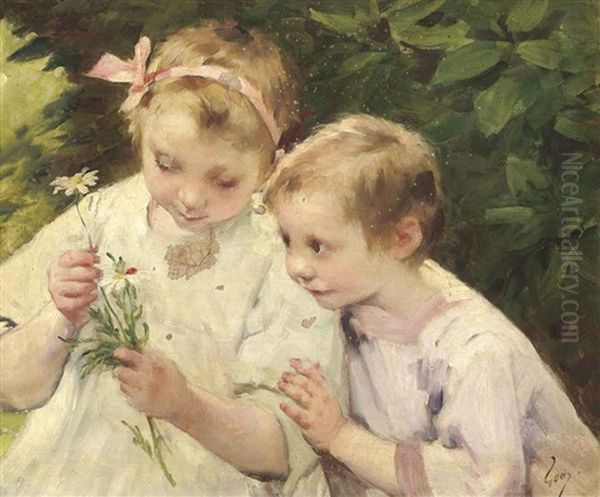
In Paris, Geoffroy enrolled at the prestigious École des Beaux-Arts, the cornerstone of academic art training in France. There, he studied under notable masters who would have instilled in him the traditional skills of drawing and composition. Among his teachers were Léon Bonnat, a renowned portraitist and figure painter known for his powerful realism, and Adam Levasseur. Another significant influence was Eugène Adan, a painter of genre scenes and landscapes, and Emile Jean-Baptiste Pinson. This academic grounding provided Geoffroy with a strong technical foundation, which he would later apply to his chosen subjects with sensitivity and precision.
Geoffroy made his debut at the Paris Salon in 1874, the official, juried art exhibition sponsored by the French government, which was the primary venue for artists to gain recognition and patronage. His early submissions began to establish his reputation, though widespread acclaim would build gradually over the subsequent decades.
The Emergence of a Distinctive Voice: The Painter of Children
While many artists of the period depicted children, Geoffroy distinguished himself by making them his central focus. He became affectionately known as "Géo," and his works were often subtitled "the painter of children." His approach was characterized by a gentle realism, avoiding excessive sentimentality while still conveying the innocence, curiosity, and sometimes the vulnerability of his young subjects. He observed children in various settings: at play, in moments of quiet contemplation, interacting with family members, and, most significantly, within the school environment.
His ability to capture authentic expressions and gestures suggests a deep empathy and patient observation. Unlike the idealized cherubs of some academic painters like William-Adolphe Bouguereau, Geoffroy's children were real, often depicted with a charming unselfconsciousness. His style, marked by fine brushwork and a careful attention to detail, lent an intimacy to his scenes. He often used a warm, harmonious palette that enhanced the tender atmosphere of his compositions.
A particularly touching aspect of his work is seen in paintings like Fleurs Pour Maman (Flowers for Mother), which beautifully captures the affectionate bond between mother and child. Such domestic scenes resonated with a public increasingly interested in the family unit and the emotional lives of children, a shift in societal perspective that gained momentum throughout the 19th century.
Geoffroy and the Classroom: Art as a Mirror to Republican Ideals
Perhaps Geoffroy's most enduring contribution lies in his extensive series of paintings depicting school life. These works coincided with the sweeping educational reforms of the French Third Republic, most notably the Jules Ferry Laws of the 1880s, which established free, compulsory, and secular primary education. Geoffroy's classroom scenes became visual embodiments of these republican ideals, celebrating the democratizing power of education.
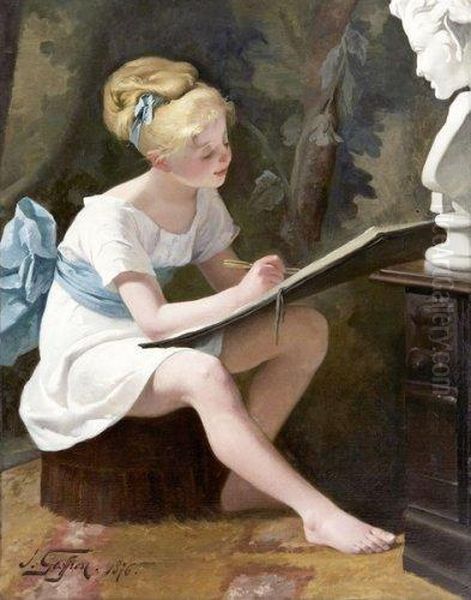
His paintings show children diligently at their desks, engaged in lessons, interacting with their teachers, or during moments of recess. Works such as En Classe, le travail des petits (In Class, the Little Ones' Work) or La Leçon de Dessin (The Drawing Lesson) are not merely genre scenes; they are documents of a transformative period in French society. They portray the school as a place of learning, discipline, and socialization, where the future citizens of the Republic were being molded.
Geoffroy often gained access to schools for his observations, sometimes through personal connections. Early in his career, he lived with Louis and Julie Girard, a couple who were teachers. They later opened a private school, and many of Geoffroy's models were drawn from their students. This close proximity allowed him an unparalleled insight into the daily rhythms and interactions of school life, which he translated onto canvas with remarkable authenticity. His depictions were generally positive, emphasizing the order, diligence, and potential inherent in the new public education system. These images were popular and widely reproduced, contributing to a public image of the modern French school.
Beyond the Canvas: Illustrator and Public Servant
Geoffroy's dedication to children extended beyond his easel paintings. He was a prolific illustrator, contributing to numerous children's books and periodicals. He notably collaborated with the publisher Pierre-Jules Hetzel, who was famous for publishing the works of Jules Verne. Geoffroy's illustrations for youth literature helped to bring stories to life for young readers, further cementing his reputation as an artist intimately connected with the world of childhood. His "Children's Painting" series, a collection of illustrations for youth books, was particularly well-received.
His commitment to education was not confined to artistic representation. Geoffroy was actively involved in public service, serving on the Children's Education Committee. He was a passionate advocate for educational opportunities and believed in nurturing the innate talents of students, rather than merely imparting technical skills. This philosophy likely informed both his teaching activities and his artistic portrayals of learning environments.
Furthermore, Geoffroy's art sometimes touched upon broader social concerns. He depicted scenes of children in hospitals or receiving medical care, reflecting contemporary anxieties about public health and child welfare. One notable work, created in collaboration with Gaston Variot, a physician and assistant to Louis Pasteur, was a large triptych titled L’oeuvre de lait (The Masterpiece of the Milk Drop), which highlighted efforts to improve infant nutrition and hygiene. This demonstrates his engagement with the scientific and social advancements of his era, aligning his art with progressive causes.
Notable Works and Artistic Recognition
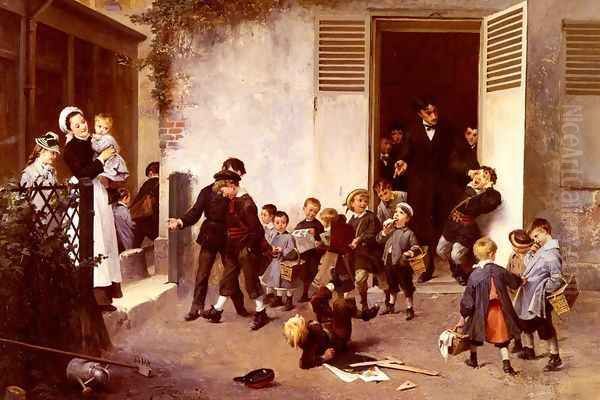
Throughout his career, Geoffroy received significant recognition for his work. He exhibited regularly at the Paris Salon, earning an honorable mention in 1883. His breakthrough came in 1886 when he was awarded both a third-class medal and a prestigious silver medal at the Salon, solidifying his standing in the art world. His dedication and talent were further acknowledged in 1887 when he was made a Chevalier (Knight) of the Legion of Honour, one of France's highest civilian awards.
The Exposition Universelle (World's Fair) of 1900 in Paris provided another major platform for Geoffroy. He was commissioned to create five large murals on educational themes for the event, a testament to his reputation as the foremost painter of school life. For his contributions to the Exposition, he was awarded a gold medal, a pinnacle of artistic achievement at the time.
Among his most celebrated paintings, beyond the numerous school scenes, are:
Fleurs Pour Maman (Flowers for Mother): A tender depiction of familial affection, showcasing his skill in capturing intimate moments.
Un Malade à l'hôpital de Berck (A Patient at the Berck Hospital): Illustrating his engagement with themes of health and social care.
Les Résignés (The Resigned Ones): A poignant scene likely depicting children facing hardship, showcasing his empathetic eye.
Sortie de Classe (Leaving Class): A vibrant and dynamic portrayal of children exiting school, full of energy and individual character.
His works were admired for their technical skill, their emotional resonance, and their reflection of contemporary social values. While not an avant-garde innovator in the mold of the Impressionists or Post-Impressionists, Geoffroy's art held a mirror to the aspirations and realities of French society, particularly concerning its youngest members.
Collaborations and Connections
Geoffroy's career was enriched by his relationships with figures both within and outside the art world. His early association with the teachers Louis and Julie Girard was formative, providing him with subjects and an intimate understanding of the school environment. This close relationship likely facilitated his access to classrooms and informed the authenticity of his depictions.
His collaboration with Dr. Gaston Variot on L’oeuvre de lait demonstrates an interesting intersection of art and science, reflecting the era's optimism about progress in public health. This project aligned Geoffroy with the legacy of figures like Louis Pasteur, whose scientific breakthroughs were transforming society.
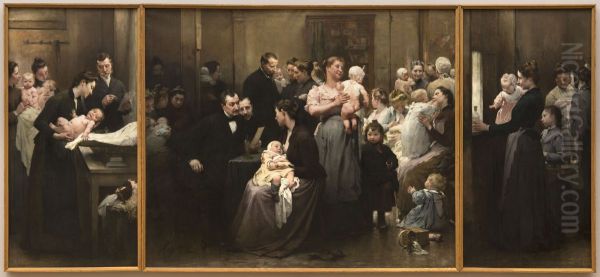
As an illustrator, his work with publishers like Hetzel connected him to the literary world and the burgeoning market for children's literature. While direct artistic collaborations with other painters are not extensively documented, he would have been keenly aware of the work of his contemporaries. He shared exhibition spaces like the Salon with a wide array of artists, from arch-academics like Jean-Léon Gérôme and Alexandre Cabanel to Realists like Jules Bastien-Lepage and Naturalists such as Léon Lhermitte, whose depictions of rural labor and peasant life shared a commitment to portraying contemporary reality, albeit with different subjects.
The art world of Paris was a competitive environment, and while Geoffroy carved out his own distinct niche, he would have been part of the broader artistic discourse. His focus on children was shared by other artists, such as the American expatriate Mary Cassatt and the French Impressionist Berthe Morisot, both of whom created sensitive portrayals of mothers and children, though often in more affluent, domestic settings and with a different stylistic approach. Geoffroy's unique contribution was his sustained focus on the public and institutional life of children, particularly in schools.
Later Years and Enduring Legacy
Henri Jules Jean Geoffroy continued to paint and advocate for education throughout his life. His dedication to his chosen themes remained steadfast. He passed away in Paris on December 25, 1924. In recognition of his lifelong contributions to French art and society, he was posthumously promoted to Officer of the Legion of Honour.
Today, Geoffroy's paintings are held in numerous French museums, including the Musée d'Orsay in Paris, and in private collections. While his name may not be as universally recognized as some of his more revolutionary contemporaries, his work holds a vital place in the history of French art and social documentation. He provides an invaluable visual record of the implementation of mass education and the evolving understanding of childhood in the late 19th and early 20th centuries.
His influence can be seen in the way he humanized the institutional setting of the school, presenting it not merely as a place of rote learning but as a dynamic environment populated by individuals with their own personalities and experiences. Art historians and social historians alike turn to his work for insights into the period. His paintings continue to charm viewers with their warmth, sincerity, and technical accomplishment. He reminds us that art can serve not only as a vehicle for aesthetic exploration but also as a powerful means of reflecting, and perhaps even shaping, societal values.
Geoffroy in the Context of His Contemporaries
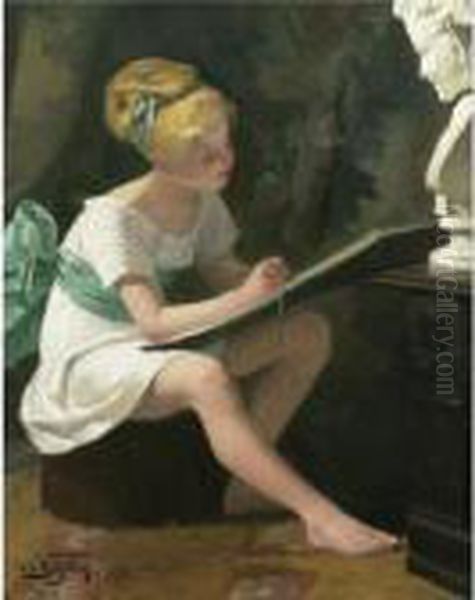
To fully appreciate Geoffroy's contribution, it is useful to place him within the rich tapestry of late 19th-century French art. While the Impressionists were capturing fleeting moments of modern life and light, and Symbolists like Gustave Moreau or Odilon Redon were exploring the realms of dream and myth, Geoffroy remained committed to a form of social realism. His detailed, narrative style was more akin to that of academic painters or genre specialists, yet his subject matter – the everyday life of children, particularly in the context of state education – was distinctly modern.
His work can be compared to that of other artists who depicted social realities. For instance, Théophile Steinlen, though working primarily in illustration and posters, also captured the lives of ordinary Parisians, including children, often with a more overtly critical or political edge. Artists like Pascal Dagnan-Bouveret continued the tradition of peasant painting established by Jean-François Millet, focusing on rural life with a meticulous realism that sometimes bordered on the photographic. Geoffroy applied a similar observational acuity to the urban environment of the schoolroom.
Unlike the often idealized or sentimentalized depictions of children by some Victorian painters in Britain, Geoffroy's children, while sympathetically portrayed, retain a sense of individuality and realism. His focus on the collective experience of schooling also sets him apart. He was not merely painting portraits of children, but chronicling a social institution and its impact on a generation.
In an era that saw the rise of photography as a documentary tool, Geoffroy's paintings offered a more nuanced and interpretive vision. His art was not simply a record; it was an affirmation of the values of education, progress, and the importance of childhood. While artists like Edgar Degas captured the dynamism of Parisian entertainment and labor, Geoffroy illuminated a quieter but equally vital aspect of modern French life.
Henri Jules Jean Geoffroy's legacy is that of an artist who found profound meaning in the ordinary. His dedication to the world of children, his insightful portrayals of school life, and his commitment to public service mark him as a unique and valuable figure. His paintings continue to speak to us, offering a window into a pivotal moment in French history and celebrating the universal experiences of childhood and learning.